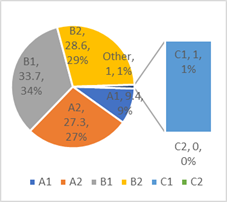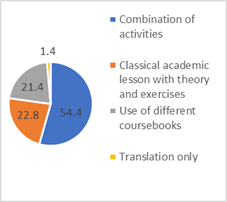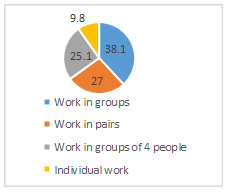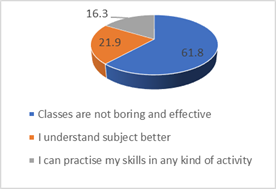Abstract
Changes in the Russian Federal State Educational Standard for the specialisation 44.03.05 Pedagogical education (with double majors: Mathematics + English) have placed new demands on bachelor graduates. Recently, state final examination involves not only passing final state exams in English, but the ability to explain Mathematics in English (including at thedefence of a thesis). It means that teaching a foreign language as a part of mentioned major should be professionally oriented and therefore, teaching it in isolation from the majors is not ineffective. Consequently, complex tasks are put to both students and teachers. Students, besides mastering General English, must study English for specific purposes. Although in the curriculum there are the following disciplines: "English language in professional communication", "Professionally oriented English", "Translation of professional literature", but they are definitely insufficient for forming foreign language competence in professional activities. As for teachers, they must not only speak a foreign language and be familiar with teaching approaches, but also understand the essence and specifics of their major subject. This article discusses teaching approaches of the practical course of the English language with a gradual, phased introduction of professional English language for mathematicians through the examples of exercises for developing reading and speaking skills. It is worth noting that innovations imply the modification of all system components of learning. In addition, long-term practice shows that training using traditional technologies allows us to develop the key core competencies for the specialty training, which suggests the need for change.
Keywords: Educationstudent,teachingEnglish for special purposesdouble majorsdeveloping speaking and reading skills
Introduction
Since its early years in the 1960s, as A. P. R. Howatt noted, English for special purposes has taken its place among other spheres of teaching English (English as a Foreign Language, English as a Second Language, English for Academic Purposes, English for Speakers of Other Languages, etc.) (Howatt,1984). Its appearance can be explained by a great number of reasons and factors, such as advances in the field of science and technology, global use of English as the language of international communication, and increasing numbers of international university students. English for Specific Purposes (ESP) differs from General English (GE) in teaching approaches and learning environment. Then, ESP and General English differ in the age of learners and their learning goals. Usually, they are the adults who already speak English at some level and want to improve their English so as to be able to use it in professional situations. An ESP course is therefore developed on the basis ofthe assessment of the learner’s needs for English (the purposes for which the learner needs English are examined). ESP focuses more on different contexts (situations) in which the language is used (Rahman, 2015). It includes topics from various areas: tourism, physics, mathematics, computer science. The peculiarity of ESP is that it is integrated into a specific subject matter which is important to the learners. In teaching General English all skills, including reading, writing, speaking, and listening are equally crucial while in ESP it depends on the needs of the learners. For example, an ESP program may be focused on the development of writing skills of students who are preparing their graduate work. ESP can also be designed to develop communicative skills of students who are studying English in order to take part in international conferences.
A significant contribution to the development of the issue cantered around developing reading and speaking skills was made by P. Strevens (1977), C. J. Moore (1983), J. C. Alderson (1984), M. A. Barnett (1988), D. Ferris, T. Tagg (1996), A. M. Johns (1997), P. L. Carrell (1998), P. Dooey (2006), M. Bojovic (2008), In Russian pedagogy and psychology the mentioned activities were developed by G.A. Kitajgorodskaya (1982), M.L. Vajsbrud, M.A. Alent'eva (2003), E.N. Solovova (2008), N.V. Gul' (2009), E.I. Passov (2010), T.M. Parieva (2011). T. Hutchinson and A. Waters (1987) outline that ESP initially takes into account students’ need. In particular, T. Dudley-Evans &M. J. St. John distinguish absolute and variable characteristics of ESP: Absolute characteristics: ESP should meet students’ requirements; ESP implements basic methodology of the subjects it is based on; ESP focuses on grammar, vocabulary, and text types when fulfilling the activities. Variable characteristics: ESP are developed for specific subjects, for example IT English; teaching approaches of ESP may differ from General English ones; ESP is aimed at adult learners; ESP implies mastering Intermediate or Advanced English. However, in some cases, Beginners may learn ESP (Dudley-Evans & John, 1998).
As it was mentioned above, all four-language skills are crucial. In terms of teaching ESP for students majoring in Mathematics and English at Kazan Federal University, focus on developing reading and speaking has not been chosen by chance. By the means of reading, then speaking activities, new vocabulary and grammar can be introduced. Based on them, it is easier to form and develop listening and writing skills.
Problem Statement
Reforming system of higher education in Russia have led to significant transformations, including
changes in Federal State Educational Standard for the speciality 44.03.05 “Pedagogical education (with double majors: Mathematics + English)" that place new demands on bachelor graduates. Currently, the state final examination involves not only passing the final state exam in English, but alsothe ability to use English when defending final qualification work. It means that the teaching of a foreign language should be professionally oriented and therefore, to teach it in isolation from the majors is not effective. We conducteda survey involving 150 students (70 first-year students and 80 second-year students) to establish their level of English and their opinion on different exercises presented in the course of lessons. The results of the questionnaire (presented as percentages) will be presented and discussed further.Consequently, complex tasks are put to students and to teachers. Students, besides learning the basic knowledge and skills in English, must study the English language for specific purposes. Although the curriculum includes the disciplines: "English language in professional communication", "Professional-oriented English", "Translation of professional literature", but they are clearly insufficient to form foreign language competence in professional activities. As for the teachers, they must not only speak a foreign language and know methods of its teaching, but also understand specifics of the major.
Research Questions
The research questions are exercises for developing reading and speaking skills in English with the aim of developing competence in mathematics within teaching practical English that should involve students in their own learning processes, improve students’ language skills, stimulate their interest and cultivate their critical thinking, supply them with opportunities to develop speaking skills in two forms: monologue and dialogue, teach to interact so as to be employed or meet workplace needs.
Purpose of the Study
The present paper is aimed at describing methods of teaching the practical course of the English language with a gradual, phased introduction of professional English for mathematicians through the examples of exercises for developing reading and speaking skills. It is worth noting that innovations imply the modification of all system components of learning – goals, objectives, updating training content, the introduction of new teaching technologies, development and creation of new textbooks and manuals. Additionally, long-term practice shows that education with the use of traditional technologies allows us to develop the key core competencies for this specialty training, which suggests the need for change.
Research Methods
Research methods contain the questionnaire form for the students with open and close questions, which is aimed to define their level of English and their opinion concerning the mentioned activities on the lessons. The survey is held among 150 first-year and second-year undergraduate students of the N.I. Lobachevsky Institute of Mathematics and Mechanics majoring in “Pedagogical education (with double majors: Mathematics + English)” at Kazan Federal University. The audience is of a various level of English knowledge. Second-year students have already practiced immersion and communicative methods in combination with reading activities on English lessons at the University whereas first-year students experience this for the first time. The methods above are used because earlier comparative analysis shows that they lead to better results in the language ability improvement amongthe students with non-linguistic majors.
Findings
The survey conducted among 150 respondents has revealed that the average level of English in the groups researched is between A2 and B2 (Fig.


Students themselves acknowledge that using the mixture of different kinds of activities makes lessons more effective, especially when they have chance to work in pairs or groups (Fig.


ESP lesson should involve the following activities, such as: oral presentations, watching lectures (listening comprehension), note-taking activities, writing CVs, abstracts, reviews, reading different articles, and oral or written analysis of the article given, etc. As didactic resources for ESP are not so many, developing activities is one of the main targets. Designing didactic materials by teachers means the usage of both authentic and adapted resources. According to Tomlinson (1998, p. xi), a teacher can use anything in order to teach activities for students (Tomlinson, 1998). The texts for reading can be taken from authentic and adapted resources. To A.C. Velazquez and Redmond (2007), both types of resources and texts are of great importance. Though, he points out that gradually adapted texts can help prepare students for reading more complicated, authentic texts (Velazquez & Redmond, 2007). While S. Bax (2003) states, for material developers… , authenticity has played a focal role (Bax, 2003). V. Baghban and Z. Zohoorian, as well as Lee (1995), Peacock (1997), Shei (2001), Lin (2004), suppose that students benefit from using authentic texts because authentic resources are more motivating (Baghban, Zohoorian, 2011).
L.V. Karpova (1999) has designed a list of the criteria when implementing authentic resources: 1. the content of authentic materials should take into consideration learners’ age, needs and aims. 2. tasks should be organized so that the learners may use their knowledge. 3. There should be cooperation between a teacher and a learner (Karpova, 1999).
The tasks developed for the course “Academic English for Mathematics” by L.R. Sakaeva and E.Kh. Shamsutdinova are based on authentic resources and implementsboth traditional and communicative approaches:
Taking into consideration that students’ level of English can vary from A2 to B2, including A1, the stages of teaching reading and vocabulary can be divided into several parts. At the beginning of the course, students are introduced to basic notions of Mathematics on materials connected with reading mathematical expressions, formulae and symbols and do simple tasks. Before starting the topic, students are asked to answer questions related to topic. For example, Greek letters in Mathematics:
Then, basic rules of reading common fractions, decimal fractions, mathematical operations, involution and evolution and others are explained. In the end, tasks to strengthen their skills are given.
-
cos (x + 2p) = cos x. -
cos (–x) = cos (x) -
sin (–x) = –sin (x)
At the next stage, students start reading popular articles, with gradual introduction into scholarly articles. Teacher should use special strategies and activities so that students may understand and remember the text to be read (Baron, 2013). These tasks are intended to direct attention, identify paragraph structure, guess the meaning from the context, connect or use background knowledge, infer, ask questions about the passages and then look for answers. In this respect, it is important to overcome difficulties connected with comprehension. The structure of the lesson can be the following:
Warming-up: A teacher introduces the topic so that the students can understand the topic;
Pre-reading: They may find out new words and expressions by means of pictures, or they may do tasks, such as matching, guessing, and scrambling. In addition to it, these activities are designed to prepare students for further reading.
While- reading: The article can be read with a teacher, in pairs or groups.
After-reading: Students fulfil comprehension activities in pairs or groups. Then, students can do speaking activities to reinforce new topical vocabulary.
Developing speaking skills is very crucial. The learners are intimidated by the academic speaking tasks, including both formal presentation tasks and small- or large-group class discussions. The reason for this intimidation maystem from the lack of sufficient linguistic competence. Another reason for such difficulties might be due to the lack of adequate speaking activities and tasks. So, the tasks include answering questions and providing solid reasoning, writing article reviews, creating presentations, surveys, interviews, quizzes, games and projects.
-
The British scientist John Wallis contributed towards development of calculus, originated idea of number line, introduced symbol ∞ for infinity, developed standard notation for powers -
The French scholar Joseph Fourierstudied periodic functions and infinite sums in which the terms are trigonometric functions -
The Russian scientist Nikolai Lobachevsky developed theory of hyperbolic geometry and curved spaces independendly of Bolyai -
The French scientist Henri Poincarécontributed to partial solution to “three body problem”, foundations of modern chaos theory, extended theory of mathematical topology, Poincaré conjecture
-
Good morning, ladies and gentlemen… -
Introducing yourself -
Let me introduce myself; my name is …..(and I am responsible for … ) -
Introducing your presentation…
Conclusion
As research shows, the approaches used to teaching students with double majors at Kazan Federal University provide interactive and communicative activities related to specific purposes of students, considering the socio-cultural dimensions of the language and the specific content, instructingstudents with strategies that they need to learn languages for specific purposes, using authentic learning materials, encouraging collaborative and group learning, making it possible to learn language skills more easily. Moreover, it creates learner-centered training, adapts both teachers’ and students’ learning styles, and provides appropriate tools for giving feedback and assessing students’ language knowledge.It should be concluded that the English language competence in the sphere of professional activities of the students are effectively formed through various research exercises, situational-playing exercises, problem situations and project-orientedapproaches. Teachers need to learn innovative exercises and training techniques purposefully because they develop the basic competence of the student form required for the profession skills, creating premises for psychological readiness to implement in actual practice mastered skills.As a result of our study it should be noted that the development of reading and speaking skills in the field of professional communication plays a huge role in learning because training system of a new generation improves every year. Having discussed educational activities with colleagues, we came to the conclusion that the tasks of our class, in addition to language learning is: formation of foreign language competence in the professional field in terms of the practical course of the English language through the increasing interest in English language.
Acknowledgments
The work is performed according to the Russian Government Program of Competitive Growth of Kazan Federal University.
References
- Baghban, V., Zohoorian, Z. (2011). A Review on the Effectiveness of using authentic materials in ESP courses. English for Specific Purposes World, 10(31), 1–14.
- Baron, M. J. B. (2013). Building ESP Content-Based Materials to Promote Strategic Reading. Profile Issues in Teachers’ Professional Development, 15(1), 139–169. Retrived from http://revistas.unal.edu.co/index.php/profile/article/view/37874/40581.
- Bax, S. (2003). The end of CLT: a context approach to language teaching. ELT Journal, 57(3), Pp 278–287.
- Dudley-Evans, T. & ST John M. J. (1998). Developments in English for specific purposes. Cambridge: Cambridge University Press.
- Howatt A. P. R. (1984). A History of English language teaching. Oxford: Oxford University Press.
- Hutchinson T.& Waters A. (1987). English for specific purposes. New York: Cambridge University Press.
- Karpova, L. V. (1999). Consider the following when selecting and using authentic materials. TESOL Matters, 9 ( 2).
- Rahman, M. (2015). English for Specific Purposes (ESP): A Holistic Review. Universal Journal of Educational Research, 3(1), 24–31. Retrieved from http://www.hrpub.org/download/20150101/UJER4-19503020.pdf.
- Rao, V. C. S. (2014). English For Science And Technology: A Learner Centered Approach. English for Specific Purposes World, 15(42).
- Velazquez, A. C. & Redmond, M. L. (2007). The Use of Authentic Texts in the K-12 Spanish Program. In McCoy, L. P. (Ed), Studies in Teaching 2007 Research Digest. Research Projects Presented at Annual Research Forum. NC, Winston-Salem, 133-138. Retrieved from http://files.eric.ed.gov/fulltext/ED503269.pdf
Copyright information

This work is licensed under a Creative Commons Attribution-NonCommercial-NoDerivatives 4.0 International License.
About this article
Publication Date
31 August 2017
Article Doi
eBook ISBN
978-1-80296-028-0
Publisher
Future Academy
Volume
29
Print ISBN (optional)
-
Edition Number
1st Edition
Pages
1-960
Subjects
Teacher, teacher training, teaching skills, teaching techniques
Cite this article as:
Sakaeva, L. R., Shamsutdinova, E. K., & Martynova, E. V. (2017). Implementing Reading And Speaking Activities For Esp Student Teachers. In R. Valeeva (Ed.), Teacher Education - IFTE 2017, vol 29. European Proceedings of Social and Behavioural Sciences (pp. 744-752). Future Academy. https://doi.org/10.15405/epsbs.2017.08.02.85

